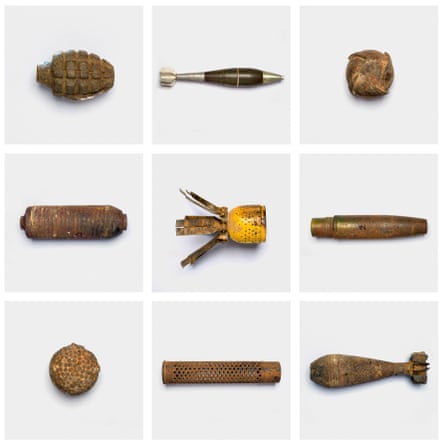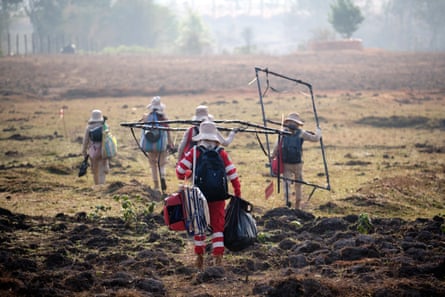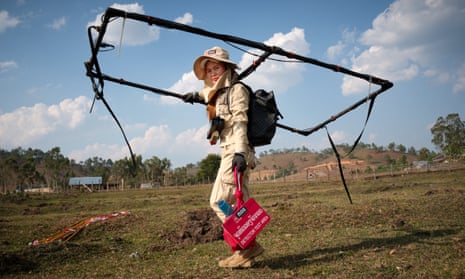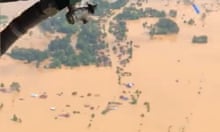Youa Thaiyang is standing at the edge of his field in the northern Laos province of Xieng Khouang. A slight man of 61, dressed in jeans and flip-flops, he’s showing a photo of a BLU-26 submunition to a community liaison officer from bomb clearance charity the Mines Advisory Group (Mag). The rusted, innocuous looking “bombie”, the size and shape of a tennis ball, is half-hidden in a pile of leaves.
Thaiyang had been burning his field that day in order to plant cassava when he spotted the BLU-26. “I was lucky, I saw it by chance – a lot of farmers around here have been killed by unexploded bombs,” he says. His near-miss is a reminder of how people here play a daily game of Russian roulette simply to farm their land.
At a news conference in March 1961, the US president, John F Kennedy, said: “I want to make it clear to the American people and to all the world that all we want in Laos is peace, not war.” But neither Kennedy, nor his promise, lasted long.

As part of US anti-communist operations in south-east Asia – commonly known as the Vietnam war – between 1964 and 1973, American pilots flew 580,000 attack sorties over Laos, an average of one planeload of bombs every eight minutes for almost a decade. By the time the last US bombs fell in April 1973, a total of 2,093,100 tonnes of ordnance had rained down on this neutral country.
To this day, Laos, a country of just 7 million people, retains the dubious accolade of being the most heavily bombed country in the world per capita.
Bombs don’t just kill during wartime, they remain live for decades. While no one knows the exact figures, upwards of 20,000 Laotians have been killed or injured by unexploded ordnance (UXO) since the end of the war. There were 63 accidents in 2021 alone. Even though the numbers are falling, Laotians are still being killed and injured as a result of a conflict that ended five decades ago. Of these, 45% are children.
“Mortar, BLU-26, grenade …” Dawang, an eight-year-old member of the Hmong Indigenous group, wears a pink hoodie branded with Disney’s Frozen, her long black hair tied in a ponytail. She is being asked to identify pictures of different types of ordnance. A mile down the road from Thaiyang’s house, a class of 30 girls is taking an explosive-risk education session at the primary school.

They sit at rows of wooden desks while two energetic Mag staff in khaki uniforms use roleplay and cartoons to educate them about the dangers lurking in their rice paddies and forests.
Most Hmong fought with the US against the communist Pathet Lao and their North Vietnamese allies. Yet all these years later, the Hmong still live with the daily, persistent threat of being injured by bombs dropped by their former brothers in arms.
When the war finally ended in 1975, the kingdom of Laos fell to the Pathet Lao and, for the next 20 years, remained largely cut off from the world. It wasn’t until 1994 that Mag and other bomb clearance organisations were allowed to begin their work. Today, Mag employs 1,200 people in Laos, 800 of them in Xieng Khouang.
In 2016, the government of Laos announced a plan to remove UXO as a barrier to development by 2030, but some believe this to be an optimistic goal. The US government’s congressional research service recently estimated that, at the current rate of clearance, it would take another 100 years to make Laos UXO-free.

On a hazy March day near Phonsavan, the capital of Xieng Khouang, nine women in wide-brimmed hats are unloading plastic chairs, a folding table and bamboo baskets of sticky rice from a white Toyota Land Cruiser. You’d be forgiven for thinking they’ve come to this sun-scorched field for a picnic, but they are one of Mag’s bomb-clearance teams, and they’re about to start their day’s work.
UXO clearance is a painstaking, repetitive business. Nicsamone, a 28-year-old with long red fingernails, pauses as her metal detector beeps and whines. “I want Laos to be clear of UXO,” she says, dropping to her knees and starting to dig. “My father was killed by a cluster bomb when I was eight. I don’t want more children to experience what I did.” After a few minutes of careful digging, she unearths an old nail.
By the end of the day, the field is pitted with holes where the team have dug up bits of suspected ordnance, but all they have to show for their hard work is a bucket full of nails and an old Beerlao can. On this (rare) occasion, they haven’t found any bombs.

UXO doesn’t just kill and maim, it restricts land use and long-term development. “While you can’t put a number on it, it’s something everyone here is aware of,” says Alex Kremer, the World Bank’s country manager for Laos, when we meet in his air-conditioned office in the capital, Vientiane. Moreover, if you overlay US bombing records with a map of the country, the hardest hit areas – Xieng Khouang and parts of the southern border with Vietnam – remain the most economically deprived.
Amid the hardship, a few enterprising locals have found a way to make a living from the US’s explosive legacy. In Ban Nateng, a small village an hour’s drive from Phonsavan, 40-year-old Somchit Poungsavat sits on a stool in front of a brick kiln, pouring silver threads of molten aluminium into a mould made of compacted ash. His open-sided workshop is stacked with the detritus of war – a 500lb bomb, a rusted rocket-propelled grenade, metal helmets, mortars, trays filled with cluster bombs – while the roof is partly constructed from the fuselage of a US T-28 plane.
Across a red dirt track, a wooden house stands on eight pillars made from cluster bomb casings.
Poungsavat, an English teacher at the village school, supplements his income by making chopsticks, spoons, key rings and other metalware from melted-down UXO, which he buys from scrap metal dealers for 40,000 kip (nearly £2) a kilo. “Yes, it can be dangerous for the people who collect the UXO – but there aren’t many jobs here and they need the money,” says Poungsavat, pouring another chopstick into the mould.
The chopsticks he’s making today are part of a 2,000-item order from an American client. As well as chopsticks, the order includes spoons and key rings shaped like the CND sign. A peace sign key ring made from bits of American bomb dropped here more than 50 years ago: you couldn’t make it up!
Laos: The Most Bombed Country on Earth is on BBC Radio 4 at 11am on 27 April






